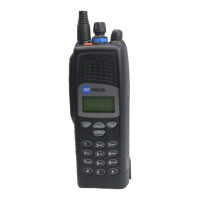318 TPA-AA-210 Hirose Accessory Adapter TP9100 Service Manual
© Tait Electronics Limited May 2005
Note If your accessory has a PTT switch in series with the microphone,
the accessory cannot be used. The PTT needs to be a separate
signal and must be made available at the connector separately; it
must not be multiplexed on any other signal
Note Connecting the Hirose adapter to the radio alone does not mute
the internal speaker of the radio. The internal speaker is muted
when the accessory is connected to the Hirose adapter.
18.2 Disassembly and Reassembly
Disassembly and reassembly is the same as the TPA-AA-201 accessory
connector kit, refer to “Disassembly and Reassembly” on page 312.
Table 18.2 Hirose accessory adapter – pins and signals
Signal name Pin Description Signal type Signal level
Output
impedance/
current
Input
impedance
HIROSE MIC 1 External microphone input
(electret)
Dynamic microphones are not
supported.
Analog audio 9.5V
rms
for 60%
modulation at 1kHz,
DC-coupled
–2.2kΩ
HIROSE PWR 2 Accessory power DC supply 3.3V nominal 100mA (max) –
HIROSE SPKR+ 3 External speaker output Analog audio +6.5V
pp
a
To drive 16Ω –
GND 4 Analog ground Ground – – –
HIROSE PTT 5 External press-to-talk input Analog DC 0 to 2.5V, PTT=0 – 27kΩ
HIROSE GPIO1 6 Accessory sense (internal
speaker disable)
3V3 CMOS high = 1
low = 0
1mA (max) –
a. Dependent on battery charge level.
Figure 18.1 Hirose accessory adapter – pinout and circuit diagram
PL2
c
PL10
g
PL6
PL1
PL12
PL11
PL13
b
e
f
d
ACC PWR
ACC GPIO1
ACC MIC
GND
ACC PTT
ACC SPKR+
Chassis GND
Accessory Connector PCB Hirose Connector
C1
4.7µF
P10
P13
P1
P2
P3
P7
HIROSE PWR
HIROSE GPIO1
HIROSE MIC
GND
HIROSE PTT
HIROSE SPKR+

